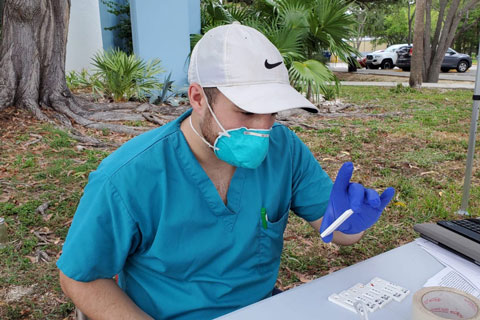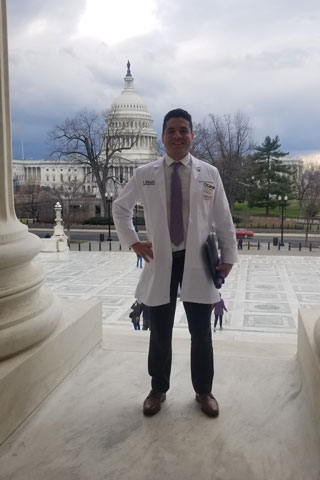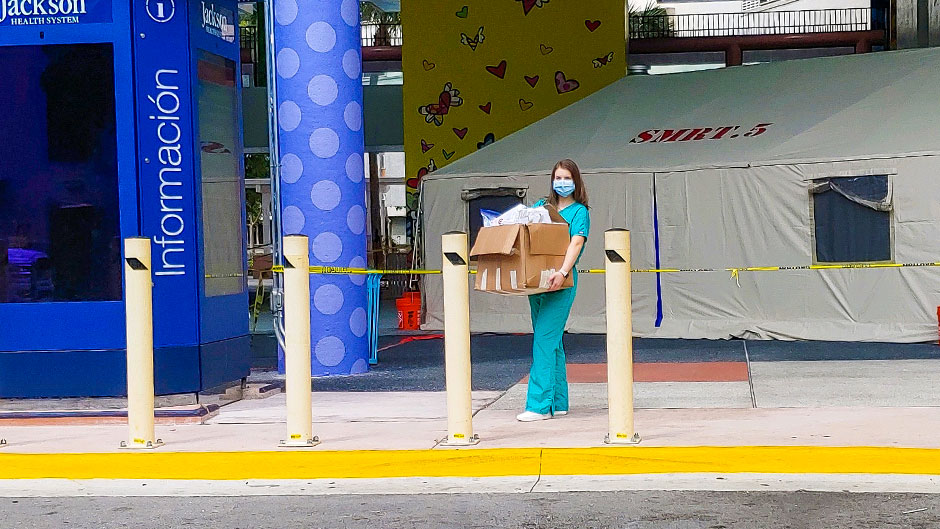I am a second-year medical student, and currently serve as the historian for the University of Miami Miller School of Medicine Student Government. In an effort to highlight the work of Miller School students during the pandemic, I asked students to provide information about what they have been doing in this area since COVID-19 surfaced earlier this year.
The response was overwhelming. Here are some of their stories:
Brandon Rose, third-year medical student

Rose spent the month of April enrolling study participants in the Surveillance Program Assessing Risk and Knowledge of Coronavirus (SPARK-C) Initiative. This past spring, as COVID-19 surged in the United States, Miami-Dade County reached out and asked Erin Kobetz, vice provost for research, to implement a testing program to show how prevalent the disease was in the county. The SPARK initiative, an alternative to symptom-based testing, provided a more representative view of the coronavirus in the community.
"At the time it was the closest thing we could get to a random sample, because if you test people who are sick that doesn’t give you the same information as if you were to randomly take people out of the population," Rose said.
The other SPARK-C captains were students Tomas Delgado, Heather Herman, Maya Lubarsky, Maria Lugo, Brianna Mussman, Varsha Prabhakar, Apoorva Rangan, and Nicole Vecin.
Alison Ohringer, second-year medical student
Ohringer founded Miami Med COVID Help, a nonprofit organized to help locate and provide PPE’s to doctors.
"When I started to see the slow rise in cases in late February, I was looking on Twitter to see how other schools were responding, especially in New York. And at first it seemed like the easiest and most helpful way for students to be involved was to help physicians who were really overwhelmed," said Ohringer.
The team collected PPE donations from the community, received and distributed bulk PPE donations, 3D printing, provided meals and care packages to health care workers, and participated in research efforts. The organization also collaborated with high schools, churches, and community groups that lent their facilities and provided volunteers for PPE and blood drives.
Nearly 250 medical students, 150 of whom attend UM, have volunteered with Miami Med COVID Help, and Ohringer has not only been inspired by health care workers who have been working through uncertain conditions, but also by her fellow students.
"It has been really amazing to see how so many people want to help and how our med students were so amped to do anything they could," Ohringer said. "It's really incredible to see how that's so normal here, and even months later we're still a very strong organization because students still want to help."
Juan M. Diaz Hernandez, first-year medical student
Diaz Hernandez worked for Lee County Emergency Medical Services as an EMT intern from April to July. He and other EMTs had to undergo changing protocols in response to COVID-19. He also witnessed how the pandemic was impacting health care workers.
"At the emergency departments, I would interact with nurses who were blatantly stressed and overextended in their jobs. Hospitals would be on internal disaster status (taking only critical patients) or with very prolonged patient offload times," he said. "The whole health care system seemed to be struggling." Diaz Hernandez said his experience only made him more committed to become a physician, especially as he prepares to start his medical education at the Miller School.
"Not even a pandemic discouraged me in the slightest from using my skills to help those in medical need," he said.
Tara Tardino, second-year medical student
Tardino and other members of the school’s DOCS Emergency Preparedness Team this spring helped rally more than 175 students to answer calls about COVID-19—when the Florida Department of Health approached the Miami Poison Control Center about relieving their call burden and staffing a COVID Hotline.
As a supervisor, Tardino was able to work alongside the poison specialists, residents, pharmacy and nursing students who also volunteered, and she took part in daily conference calls with the Florida Department of Health.
"It was exciting, there were new developments every day, new changes, new CDC guidelines, new information," she said. "It was also a little intimidating, because we didn’t know that much. So, we often didn’t have that many answers to give callers, but I like to think we stopped some of the spread and also helped ease some people's worries and provide some public health education."
Henry Olano, second-year medical student

When his medical mission to Nicaragua was cancelled, Olano began to work with Connect for COVID to help patients with COVID-19 stay digitally connected to their loved ones, but he transitioned out of that role when he began an internship during the summer with Democratic Rep. Donna Shalala. He listened in on hearings related to COVID-19, provided recommendations, and kept the congresswoman's office up to date on the hearings he attended. He was also able to gain a deeper perspective of the dynamics in Congress.
"It was eye opening. I think I was a lot more idealistic before I went to Congress to intern. And coming back, I realize there's definitely a huge divide between the aisles on what people will listen to—even things like health care, which shouldn’t be a political issue,” he said.
With all that he learned through this experience, Olano stressed the importance of civic engagement, especially from people in health care. "It helped me understand that what Congress needs is people who have these experiences to speak up," he said.
Haley Hullfish, second-year medical student
Hullfish coordinated care package donations under Miami Med COVID Help. After collecting donations from vendors and community members, she and other students packaged the items—including baked goods, snacks, CBD oil, and skin care products, face-mask clips, and homemade face masks—and distributed nearly 400 care packages and 200 dental care product packages to Jackson Memorial and Holy Cross hospitals.
The face masks were also donated to "Buddy Systems," an organization that delivers food to people in Miami who are elderly and low-income. "I thought that they could give out a lot of these cloth masks because they see a lot of people and have a lot of volunteers," she said. "So, I donated 600 of those to them, and I've seen people wearing them on their Instagram story, which is nice."
Hullfish has appreciated the overwhelming support from the Miami community. "It's been great to see how everyone in the community has been helping," she said. "All the bakers and shops that have been helping have been awesome, so I really appreciated that."
Allison Kumnick, fourth-year student
This spring, while studying for exams, Kumnick was also recording podcasts for Regional Medical Campus (RMC) students who were preparing to begin their third-year rotations. Kumnick listens to podcasts often and utilized the format because of the long commutes to some rotation sites for RMC students.
Kumnick aimed to provide future students with information that would help them prepare for rotations and encourage them to prioritize their well-being and take time to reflect during challenging times.
"We talked about the first time a patient dies, which is a hard thing during third year," she said. "One of my friends and I were in the same patient group, and one of our patients died early, like in our first four weeks of third year. So, we talked a little bit about that and how to reflect."
The podcast episodes also consist of information that is helpful for rotations that is not generally in orientation guides, such as what students should keep in their pockets during the day and what a typical day might look like. The series consists of one hour-long podcast in which Kumnick discusses wellness and six podcast episodes that are 10-15 minutes each where she recruited her classmates to provide advice on rotations for specific specialties.
"It was fun interviewing people because I hadn't seen my friends in like two months. And every time I finished an interview, we ended up talking for 30 minutes, because everyone was socially deprived," she said.
Seiya Liu, Minji Kim, and Nick Lee, second-year students

Liu, Kim, and Lee conducted research studies examining the effects of anti-Asian rhetoric and discrimination on Asian-American communities in Florida. The idea for the project came from stories Liu had heard from family members in California about discrimination that they faced when COVID-19 cases began to increase in the United States.
"I wanted to see what's the experience of Asian-Americans and the Asian people here and how that might have changed with COVID," said Liu. Added Kim: "My parents were experiencing racism. People were rolling their windows down and yelling at my dad."
They created a survey for Asian-Americans in Florida that focused on demographics, discrimination, and health care. "The three of us spent a good month just calling Asian community members throughout Florida in our broken Korean and broken Mandarin, asking everyone to distribute our surveys," Kim said.
They also went to churches and grocery stores to distribute the surveys. They received 258 responses, about 200 of whom were Asian.
"Our studies found that Asians are significantly more likely to experience discrimination during COVID than non-Asians," Kim said. "We also looked into anticipation of discrimination after the pandemic."
Lee, Kim, and Liu hope to collaborate with researchers in California to compare data and to broaden the scope of their work.
Irene Goo, second-year student
When quarantine and other restrictions prevented students from taking part in their usual community work, Goo connected with the organization ContraCOVID through Instagram. This allowed her to contribute to community efforts and assist community programs in gaining a wider audience through advertisements across platforms.
Goo worked with other second year students Danny Castaneda, Erin Dandes, and Nick Lee to take part in a Community Resource Guide. They compiled information about social assistance programs, COVID-19, health care, and unemployment, and distributed these guides to Spanish and Creole speaking communities in Miami. The guides also provided other information about bill deferrals, financial assistance, and food resources, which is one of most significant issues that people are experiencing relating to the pandemic. Goo and her team collaborated with community partners, including churches and local organizations to ensure accessibility and a widespread audience for available outreach efforts.
"We saw that a lot of the community had already banded together and started their own initiatives, but it was hard to know what was going on," said Goo. "So, we came up with this idea of community resource guides that compiled things that already existed in your community that you could take advantage of, and then also [added] some national level resources and information. It was geared toward providing social and financial assistance to immigrant families by compiling it into one place, because there was a lot of information overload when COVID started."
Christina Barkas, second-year student
Barkas turned her interest in medical storytelling and podcasts and created Miami Med Speaks, a project open to health professionals and health profession students at the University of Miami.
"Originally, I was planning to have a live storytelling event in Miami as part of my project with the Ethics and Humanities pathway," Barkas said. "But, like all things this year, plans change. So, I thought that maybe we could change it to a virtual format where people could submit video stories explaining a meaningful moment that's happened over the course of the pandemic."
The result, she said, was that “we get to see people at their most vulnerable, and we witness all aspects of life: birth, disease, death and all these intimate parts of people's lives. And it's really easy to get lost in the fast pace of it all."
People also were provided a creative outlet for reflection and a platform that humanized health care providers as they shared experiences and emotions.
"Storytelling can also demystify medicine and the art of healing. When I start talking to people about the stories that they want to share or watch their videos, it's really inspiring to hear how people have taken this time to develop a new project or try and solve some sort of problem, and their emotional journey through that," Barkas said.
Jared Silberlust, fourth-year student
After his clinical rotations were canceled in March, Silberlust looked for alternative ways to care for patients, and he realized that other schools were offering telemedicine opportunities. Silberlust recognized the numerous complications that could arise from performing patient care virtually, and reached out to Dr. Gauri Agarwal, dean for the clinical curriculum on the Regional Medical Campus, inquiring about how Miller students can learn more about telemedicine.
"I wanted the tools to be a better doctor," Silberlust said.
Silberlust worked on condensing resources about telemedicine that Agarwal shared with him, and he created a presentation and recorded himself giving the lecture.
"Basically, the lecture was 'Telemedicine 101:' how to use telemedicine, what the implications are, why medical students should care how to do a remote physical exam, what website manner is versus bedside manner," Silberlust noted. "Things that I wouldn’t have necessarily thought of if I didn’t specifically look into it."
The lecture was assigned to all third-year students; and through the telemedicine initiative, some students were able to virtually see patients who had tested positive for COVID-19—which at the time, some resident physicians at Jackson weren't even able to do due to hospital restrictions. More than 400 Miller students have viewed Silberlust's lecture, and more than 100 were paired with physicians to gain more telemedicine experience.
"Our results were extremely successful. Everyone improved in every single competency that we tested, including overall ability, note writing ability, physical exam ability, and communication skills," he said. "Now, because it was successful, the clerkships are incorporating parts of that curriculum into the clerkship."
Alessandra Della Porta, third-year student
Della Porta volunteered at the Poison Control Center's COVID Hotline and published a review of the toxicity of chloroquine and hydroxychloroquine in hopes of helping patients who may overdose on either drug in an attempt to fight COVID-19.
Using public data, Della Porta and a toxicologist at the Poison Control Center discovered that there was in fact an increase in calls related to overdoses and general questions about hydroxychloroquine and chloroquine.
Della Porta and fellow Miller students Kasha Bornstein and Austin Coye explored the available literature about COVID-19, hydroxychloroquine, and chloroquine. They realized that there wasn’t a substantial paper that had been published recently about how to treat overdoses in people who were taking chloroquine and hydroxychloroquine.
"We wanted to write a paper that talks about what an overdose looks like and how to treat it., Because, in the last 20 years since a paper like that had been published, there have been so many medical advancements—like putting people on ECMO and doing lipid emulsion therapy." Della Porta said.
The paper has been published in the American Journal of Emergency Medicine. It outlines a treatment algorithm that Della Porta stated could provide recommendations for doctors regarding treating patients who are suffering from overdoses of hydroxychloroquine or chloroquine. And it would hopefully benefit patients in the future.

